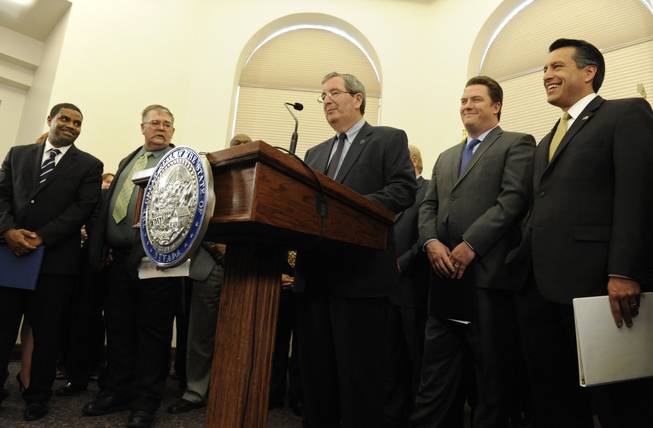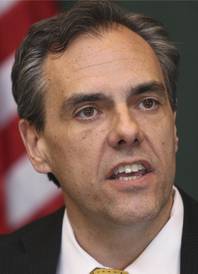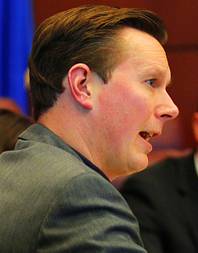
AP Photo/Lisa J. Tolda
Gov. Brian Sandoval, right, is joined by legislative leaders Sen. Steven Horsford, D-North Las Vegas, Assemblyman Pete Goicoechea, R-Eureka, Sen. Mike McGinness, R-Fallon, and Assembly Speaker John Oceguera, D-Las Vegas to announce a budget agreement Wednesday, June 1, 2011, at the Nevada Legislative Building in Carson City.
Friday, July 1, 2011 | 2 a.m.

Dale Erquiaga

Ben Kieckhefer
Sun coverage
A fifth round of budget cuts will take effect today, as the state implements the budget passed by the Legislature and signed by the governor. To hear the chorus of elected officials, both Democrats and Republicans, government has been cut to the bone as the Great Recession has dragged on.
But in one respect, the new budget’s effect is slight. Out of the almost 17,000 state employees, only 37 have received layoff notices effective today, the start of the new fiscal year.
State workers have once again largely escaped this recession’s cruelest effect — job loss — with a combination of increased retirements, elimination of vacant positions and cuts to pay and benefits.
The number, although still preliminary, surprised Republicans, Democrats and labor leaders, who expected a higher total.
Although all made it clear they didn’t want to add to Nevada’s already highest-in-the-nation unemployment, some wondered if the heated rhetoric during the legislative session — with some claiming the streets would run red with layoffs unless budget cuts were reversed — matched the actual outcome.
“If this turns out to be another case of ‘the sky is falling,’ I’m going to have a hard time believing anyone until I’m hit by a cloud,” said state Sen. Ben Kieckhefer, R-Reno, who voted for extending the tax increase.
For those who have lost their jobs, had family members’ work downsized or watched co-workers glumly pack up belongings after meeting with the boss, the layoff has become the defining experience of the recession.
That government employees have, to a large degree, escaped such a fate has set them apart from private-sector workers.
Some of this, of course, is to be expected.
“Government provides an essential safety net,” said Dale Erquiaga, Gov. Brian Sandoval’s senior adviser. “It has to continue at a certain level. We’re different from a company selling goods no one can buy in a recession. Demand for government services goes up in a recession.”
And even during its period of booming growth, Nevada had the fewest public employees per capita; state employees also made significantly less on average than their counterparts in local government.
The state budget will eliminate 665 full-time positions over the next two years, under the budget signed by Sandoval, according to the budget office.
Erquiaga said departments had “done a good job of placing people in other positions.”
He called it a “good outcome that only 37 people are laid off.”
But he said he understood if the public will be more skeptical when the public sector makes dire predictions.
“This has not resulted in mass layoffs as some predicted,” he said, naming specifically higher education and school district officials.
Higher education officials were still tallying numbers Thursday, and wouldn’t have complete figures until next week. The Clark County School District said layoffs will depend on union concessions.
Layoffs are, to be sure, just one measure of the economy’s toll — the stress of high unemployment, a failing housing market, collapsed construction industry and an eroded tourism base.
State workers have over the past two years had to take once-a-month furloughs. They will have to take six unpaid furlough days a year starting today, plus a 2.5 percent pay cut. In addition, they have to pay more toward their pensions, and saw dramatic reductions in health care benefits.
In total, it’s a reduction in take home pay of about 10 percent, according to Vishnu Subramaniam, chief of staff of the AFSCME Local 4041, the state’s largest employee union.
Even where employment is flat, state employees face much higher workloads as people look to government for help.
The state’s Welfare and Supportive Services Division, which gives out Medicaid, food stamps and welfare, had 1,247 workers approved for the upcoming two years, the same number it had this year. But with the numbers seeking assistance growing, the agency projects workers there will have gone from fielding 160 cases per employee to 306.
“Our employees are being asked to do more and more every day,” said Romaine Gilliland, administrator of the division. “With this economy still suffering, they see more clients every day.”
That, he said, has led to higher error rates and the possibility of more fraud. It has also led to the state meeting its deadlines about 85 percent of the time.
“That sounds like a high number, unless you’re one of the families waiting for food stamps,” he said.

Join the Discussion:
Check this out for a full explanation of our conversion to the LiveFyre commenting system and instructions on how to sign up for an account.
Full comments policy